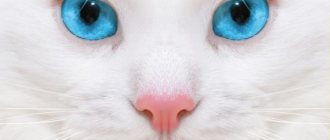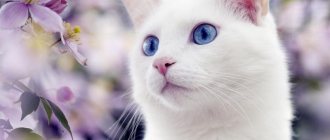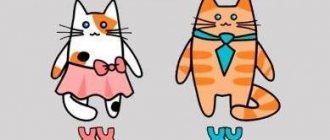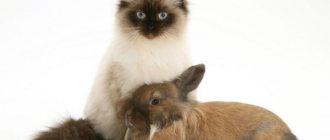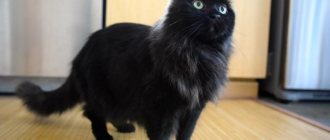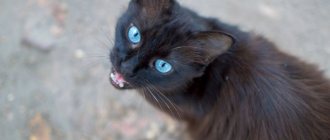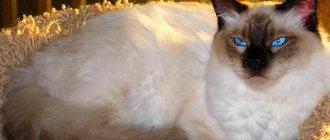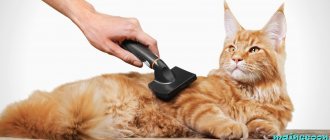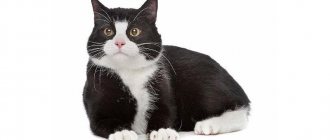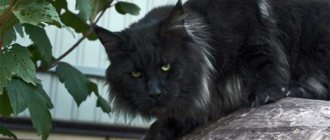To designate the “raccoon cat” standard, felinologists have adopted the EMS code system. Breeders study the genetic predisposition of pets to a certain color and fur pattern. The main names and their variations have been studied, depending on the tone, location of stripes and figures on the wool. The expected shade of the pet's eyes is known.
Who is better: a Bengal cat or a Maine Coon - what do you need to know to make the right choice?
If it is impossible to decide on the breed that is chosen for the family, it is recommended to initially study information about the characteristics of the breeds, the characteristics of cats, behavior, health, nutrition and care for them. Maine Coons and Bengal cats are considered popular. But when comparing these representatives, you can notice that they differ in all respects and you need to select the animal that matches the owner’s character.
Description and characteristics of breeds
Maine Coon cat
A purebred representative of the breed is endowed with the following appearance:
Breeders note that Maine Coons have a calm, easy-going character, they are friendly, sociable and kind. They love active recreation and play with people, especially children. Cats are easy to train and educate, endowed with intelligence and developed intuition. They are curious, pay attention to all objects that make sounds.
Maine Coons can develop hip dysplasia due to the large size of the cat and cardiomyopathy, a disease of the cardiovascular system.
Caring for pets does not require much effort and time. It is recommended to bathe them weekly or when they get dirty. Brushing should occur 1-2 times a week, even with long hair; cats’ hair does not get tangled into clumps and is easy to comb. It is necessary to get vaccinated in a timely manner and give vitamins. Both specialized feed and natural food are used for the diet.
Bengal cat
Representatives of the breed are smart and active, they are cheerful and sociable. But sometimes their excessive activity becomes a big disadvantage. They are easy to train, learn tricks, but can be mischievous in the house. Thus, problems arise with peeled wallpaper, scratched furniture, and broken interior items. To avoid this, it is recommended to purchase the maximum number of toys for your cat so that he does not get bored. Like Maine Coons, they love water and bathes, but unlike them, they prefer to sit in the arms of their owner around the clock, basking in love and affection.
Bengal cats are relatively small in size, with a well-developed body. The paws are squat but powerful, the tail is elongated. The coat is smooth, silky with a beautiful spotted color. Males are usually heavier than females and weigh 5-7 kilograms, and they live up to 12 years. Genetic diseases are the same as for Maine Coons, but the list is also complemented by retinal atrophy and luxation of the patella, which are inherited. Cats have short fur and require minimal grooming. It is enough to bathe your pets with specialized shampoos several times a month and periodically comb their hair. It is advisable not to let the cat out onto the street or balcony, because Bengals have a highly developed hunting instinct, and they can hunt birds and small animals.
Varieties
Despite its American origin, the breed was established and developed mostly on European territory.
Local breeders were developing new lines. As a result, certain external signs and character traits characteristic of modern Maine Coons have become established.
This is how two varieties of this breed were formed: American and European.
American type
Cats of this species are classic representatives. American breeders work to preserve their original appearance and purebred quality.
Aborigines have a number of distinctive features, the main of which are:
- strong skeleton;
- well-developed muscle tissue;
- wide chest;
- voluminous skull;
- high forehead;
- short muzzle;
- round eye shape;
- high-set small ears;
- long whiskers;
- bushy tail;
- very thick and long hair;
- pronounced tabi color with a clear contrasting pattern.
European type
In the 70s of the 20th century, breeders managed to develop a new intrabreed variety. European Maine Coons are significantly different from Aboriginals. They are characterized by the following signs:
- extended body;
- elongated wedge-shaped muzzle;
- low forehead;
- high-set large ears with “lynx” tassels;
- slanted, oval-shaped eyes;
- high limbs;
- a long tail;
- moderately pronounced coat, lack of a lush mane and “pants”;
- plain smoky color.
In addition to “pure” representatives of each type, there are individuals that combine the external features of both varieties.
Advantages and disadvantages
The main advantages of Bengal cats are that they are very gentle, affectionate and loyal. Their boundless love for children makes Bengals the best pets in families with newborn babies. The advantage of this breed is walking on a leash in the fresh air; cats will become excellent companions in active recreation. Animals often mark their territory, so it is better to castrate or neuter them, this is the main drawback.
The advantage of Maine Coons is that they quickly get used to their owners and become full-fledged members of the family. Cats are affectionate, gentle, love attention and care. Their main advantage is their mind, intellect and intelligence. Only the Maine Coon breed can talk, that is, make sounds very similar to human conversation. The main disadvantage is its rather large size; it is difficult to keep such an animal in small apartments due to limited space and cats have difficulty getting along with other pets.
Nurseries
Since Maine Coons are a show-class breed, their breeders are very attentive to where the kittens go, how they plan to keep them and in what capacity - for breeding, for exhibitions, for themselves.
You can find a cattery through a cat club, on the Internet, or at exhibitions.
You can wait for the kittens to arrive by booking them in advance. Catteries usually have their own Internet - a resource where information about all cats, cats, matings, exhibitions, and connections with foreign breeders is indicated. Professional breeders are interested in acquiring new animals every two to three years.
If the same animals constantly mate with each other, and there is no influx of new blood, it means that the owner makes money from breeding and selling, and he is not interested in improving the quality of the breed. A professional breeder will definitely invite the future buyer to the nursery, show all the animals, and help with choosing a kitten. If the weight of the male cat has been declared, you can ask for a control weighing - this is a normal procedure.
Before purchasing a kitten, you must find out whether the nursery is registered in the felinological system; this is a guarantee of purebred animals.
There are nurseries in apartments and outside the city. Even if it is located far from the city, it is better to visit it. When purchasing, an agreement will be concluded between the buyer and the seller on how the animal is planned to be used, how it can and cannot be crossed, and how the matings will take place. Nurseries provide all documents for kittens.
Who to choose: comparative characteristics
When comparing representatives of these breeds, we can conclude that Maine Coons are playful, friendly, and affectionate. Despite their overall size, they are graceful and slender, intellectually developed and easy to train. Proud cats, with a sense of their own dignity, will not beg for food from their owners and will not touch someone else's bowl. Although Maine Coons love to play, there will be no problems with broken things or scratched furniture in the house. Because of their inherent aristocracy, they are neat and balanced.
Bengal cats are comparatively even more active representatives than Maine Coons. Representatives of Bengals need special attention throughout the day, so it is recommended to be prepared for this before purchasing such a cat. Bengal representatives meow a lot, so when choosing such a pet it is recommended to take this factor into account. Cats do not like to be held, they should always have their own space. To choose the right furry animal for the whole family, it is better to first carefully study the character, behavior and health of cats of each breed.
Education
On the one hand, Maine Coons are freedom-loving and independent and do not lend themselves to drill or “dog” training, on the other hand, they are very smart and trainable animals.
At an early age, the kitten is taught to use a litter tray and scratching post.
In further training, the method of prohibitions and rewards is used. Spanking, beating, or any physical punishment against these cats is excluded. Maine Coons are humane, they must know their owner as a source of affection. You can use a spray bottle of warm water to teach prohibitions.
When a cat scratches something that is not allowed or climbs onto a forbidden object, it is lightly sprayed with water, creating discomfort. You can use odors that are unpleasant for your pet, for example, citrus, by treating them, for example, with curtains that are torn or torn by a cat. You can train your Maine Coon using your favorite food, encouraging him to perform various actions, or through play.
Sizes and weight of adult Bengals
The Bengal pet is quite large. The height of an adult is 39–41 cm at the withers, the length of the body with tail reaches 90 cm.
Weight varies between females and males. An adult female weighs 3.5–5.5 kg. The male is heavier, his weight can reach 6–8 kg. These dimensions and weight parameters are average. It is not considered a deviation from the norm if the animal’s parameters are slightly higher or lower than specified.
The size of Bengal cats is significantly influenced by the genetic history of the breed. To develop the Bengal breed in the 1980s, a wild leopard cat living in Asian forests was crossed with 5 domestic breeds (Abyssinian, Egyptian, Bombay, British Shorthair and Ocicat).
The listed breeds vary significantly in size: some weigh 4–5 kg, others 6–8 kg.
Important! Size is determined by the extent to which a representative of the Bengal breed is genetically removed from a large leopard cat. The more diluted the genetic link with the wild Asian ancestor, the smaller the body of the domestic cat.
If the Bengal cat is small, then its size is most likely influenced by a close genetic relationship with Abyssinian cats, weighing no more than 6 kg. And if the pet is large, weighing about 8 kg, then its close relative is probably the British Shorthair.
How old do Bengal cats grow?
The age when a Bengal ceases to be a kitten and becomes an adult is 1 year. However, the one-year-old pet is still small and continues to grow actively. A Bengal cat is considered mature after reaching 2 years of age, when growth stops, although some individuals continue to grow larger up to 3 years of age.
There is no need to worry if the cat’s growth has not stopped by the age of 2, and the body size slightly exceeds the standard. Bengals are hybrids, so in some individuals adolescence is prolonged, while in others it ends on time.
Main reasons for color change
Eye color depends on the amount of pigment in the cells of the cornea, the formation of which begins in the embryonic period.
The cat's gestation period ranges from 55 to 63 days. In this short period of time, inside the mother, two united cells must develop into a relatively large, smoothly working organism.
The mother's resources are limited, so the melanin she synthesizes is primarily sent to the skin and fur cells of the fetus. This allows you to quickly form reliable covers for effective thermoregulation and protect the kitten from an aggressive external environment. In this case, the cells of the iris are deficient in melanin, which is why they remain colorless during birth and several weeks later. As the kitten grows, its eyes gradually open, vision becomes clearer, and the eyes acquire a color dictated by breed and heredity.
Anatomically, the cat's cornea consists of two layers: stroma (upper) and epithelium (lower).
The degree of saturation of the stroma with melanin determines the shade of the kitten’s eyes. If there is little of this substance in the cells of the iris, the eyes will be blue or blue. If a little more - green. With a high melanin content, the eyes turn coppery brown.
Kitten weight table by age
The size of a Bengal kitten reflects its health. Cubs with congenital defects, parasitic diseases, genetic abnormalities, and those with poor nutrition develop poorly.
To promptly identify deviations from the standard, the owner must weigh the kitten regularly. In the first weeks of life, weighing should be daily, then twice a week.
The normal weight of a Bengal kitten at different stages of life is shown in the table.
| animal age, months | average normal body weight, kg |
| first week after birth | 0,08–0,12 |
| 1st month | 0,4–0,5 |
| 2–3 | 0,8–2,4 |
| 4–5 | 2,7–3,6 |
| 6 | 3–3,8 |
| 7 | 4 |
| 8–9 | 4,2–6 |
| 10–12 | 4,5–6 |
A newborn Bengal kitten weighs 80–120 g, but after a week this figure doubles.
Recommendation! If a newborn kitten feeding on mother's milk is not recovering well, then the nursing cat should be given more protein and vitamin food.
The kitten is gaining weight unevenly. Once the baby reaches 2 months of age, its growth slows down. But as soon as its weight exceeds 1 kg, development becomes rapid again. By 7–9 months of age, body development and mass accumulation are once again inhibited.
In females, growth acceleration is no longer observed; body size remains almost unchanged. But males resume active development until 2 years of age.
When do major changes occur?
The first changes in the shade of the cornea can be seen already in the fourth week of a kitten’s life. Melanin begins to concentrate in the pigment centers of the iris, and gradually small patches of a different color appear on the bluish field.
By 4 months, you can get an impression of the approximate color of the pupils. The final shade will be established only upon reaching the age of two, when the formation of the body is completed and the kitten enters the maturity phase.
Since the shade of the iris is a determining factor for the breed, it is recommended to choose a kitten at the age of 4-6 months. At this time, even an inexperienced breeder will be able to correctly determine whether the future pet meets the breed standards.
What to do if your Bengal begins to gain weight poorly
Bengal cats can gain or lose weight for a variety of reasons.
Attention! If a cat is visually large and massive, this does not always mean that it is obese. Bengal pets are physically active and mobile, so their impressive size may be due to their developed muscle mass.
Exhaustion and obesity in a Bengal cat should be determined, as in dogs, not by body size, but by weight.
Most often, obesity in Bengals has two causes:
There are more factors that cause exhaustion in a cat, and some of them require veterinarian intervention and urgent treatment. A Bengal pet may lose weight for the following reasons:
Bengal cats are large, harmoniously built, muscular animals. If they eat properly and maintain physical activity, they do not tend to gain weight. The owner must monitor changes in the pet's size and body weight.
If there are significant deviations from the norm to a greater or lesser extent, the Bengal should be immediately shown to a veterinarian in order to prevent serious illnesses.
Source
Who is bigger, Maine Coon or Bengal cat?
The Maine Coon is a native cat breed of the United States of America that originated from cats living on the farms of Northeast America in Maine. Initially, only black tabby cats were called Maine Coons. Due to their coat color, powerful build and huge tail, these cats looked like raccoons (hence the name of the breed - literally “Maine raccoon”. “Maine” is the name of the state of Maine, “coon” is the second part of the word “raccoon”, that is “ raccoon"). Maine Coon cats are distinguished by their friendly nature and especially large size. Among domestic cats, this is a large breed: males can weigh 15 kilograms, females up to 8 kilograms. Although Maine Coons have semi-long hair, cats of this breed do not require frequent brushing, like Persians. The first Maine Coon is considered to be a cat named Captain-Jenks-of-the-Sea-Cavalry. It was shown at exhibitions in Boston and New York in 1861 and marked the beginning of the early popularity of the breed, but at the turn of the 19th and 20th centuries, Maine Coons were surpassed by the fluffier Persians. The Maine Coon as a breed managed to survive only because farmers paid tribute to its size and excellent hunting qualities. On the Isle of Man, in 1993, a coin was issued dedicated to the Maine Coon breed. The 1 crown (25 pence) coins were made from cupro-nickel, silver and gold [1]. Body and size: Large breed among domestic cats (some individuals reach 15 kilograms in weight). The maximum recorded body length is 1.23 meters. Large to very large, muscular, elongated and broad-boned body of a rectangular format. The muscular neck is of medium length. The limbs are of medium length, strong, muscular, the paws are large with tufts of hair between the pads. The tail is long, at least to the shoulder, tapering to a pointed tip, covered with flowing hair.
Head: Large, massive, straight, sharp outlines. High cheekbones, medium length nose.
Ears: Very large, wide at the base, pointed, set high, almost vertical. The distance between the ears is no more than the width of one ear. Brushes protrude beyond the edges of the ears; tassels on the ears make Maine Coons look like a lynx.
Eyes: Eyes are large, round, slightly slanted, and can be amber, golden, green or yellow.
Maine Coon fishing
Correct display of the Maine Coon Coat: The hair is short on the head and shoulders, except for the collar, and distinctly lengthens along the back, sides and belly. The thick undercoat, soft and fine, is covered with coarser, dense hair. The thick, free-flowing, water-repellent topcoat extends to the back, sides and top of the tail.
Colors: Chocolate, brown and corresponding weakened colors (lilac and fawn) are not accepted in any combination, nor are acromelanic colors accepted. All other colors are recognized. Red Marble - Red Maine Coons are characterized by a bright red color, with a clear marbled pattern, distinguishing them from the paler “ginger” color characteristic of ordinary cats.
Personality: Friendly, peaceful and flexible. Maine Coons are very careful - if there is an obstacle in the animal’s path, it will not throw it off, but go around it. If there is a scratching post, the furniture will be fine. The Maine Coon does not like narrow spaces, so it does not climb anywhere. Despite its large size and slightly menacing appearance, this breed has a particularly affectionate character. They easily adapt to the owner and the habitat in general. As a rule, they have a high level of “cat IQ”; They are easier to train and train than many other breeds. By nature, the Maine Coon is a good-natured and active pet. Very loyal to “their” family, but careful with strangers.
Source
Standard colors
The standard eye shades for cats are:
- Green. Allowed in cats with a predominance of black, blue, lilac color, coat of cinnamon, fawn, chinchilla color.
- Yellow. Characteristic of tabby cats.
- Copper. Allowed for cats with black, chocolate, lilac, blue, red, cream color.
- Icy and light blue. Acceptable for all white cats.
However, white cats with blue eyes are often deaf in both ears. Among white pets with one blue eye (heterochromia), unilateral deafness (on the side of the blue eye) is observed.
Comparison of cat personalities: Maine Coon
Kittens of this breed are very playful and friendly, they grow up to about 3-5 years. And they grow up to be large animals. But for all their large sizes, they have an elegant grace and look royally noble. They have extraordinary intelligence and are easy to train. These cats have a sense of self-respect and will never beg for food or eat from someone else's bowl.
Also, you will not have problems with broken vases or torn wallpaper and scratched furniture. They behave decently and peacefully, as befits aristocrats. Another interesting feature is the voice of this animal; they produce very melodic and pleasant sounds, in no way compatible with their large size.
If you decide to adopt a Maine Coon kitten, it will not be at all difficult to maintain it, since their fur is very silky and practically does not tangle.
Health
Maine raccoons boast excellent health and strong immunity.
The first generations of this cat family did not have any health problems. Crossing with other breeds worsened the picture. This led to the emergence of hereditary diseases. These include weak back muscles and heart problems. The animal may suffer from joint problems. Pathologies are noticeable already at 12 weeks of a baby’s life. Possible kidney problems. Regular visits to the veterinarian will help prevent urolithiasis. And also proper nutrition.
A specific ailment for these animals can be problems with hair. They arise due to the abuse of bath days. Shampoo can also damage the fur.
With proper care, the life expectancy of a Maine Coon will be 15-20 years. The owner of the animal needs to carefully monitor changes in the behavior of his tailed friend. It's the right way to respond to this. For example, a pet suddenly became partial to ornamental plants. Usually these cats do without plant food. Such an addiction may indicate a lack of vitamins. The owner’s task will be to purchase a vitamin complex.
Comparison of cat characters: British and Scottish breeds
Comparing the British and Scottish breeds with the Maykun breed, the British are more suitable in size, but of course they will not have such elegance and grace. The British are stockier and have wider bones. Kittens of the Scottish and British breeds are similar to each other. But the Scots have a more elongated flexible body. The character of these breeds can be very contradictory.
The British are more suitable for families without children. Since British cats are essentially introverts, they love isolation and loneliness. And they prefer to live their own lives. Such a cat will not become a friend for your child and he will be bored with her.
Scots are more willing to communicate with people and even get bored when their owners are not at home.
But neither the Scot nor the Briton likes to be picked up for a long time and tormented by children with their caresses. Therefore, a very intrusive child can receive an aggressive rebuff, even to the point of releasing their claws. What cannot be said about the Mey Coon breed, they are friendly, affectionate and very gentle.
And they will never harm your child, and also get along easily with other pets, thanks to their peaceful and calm disposition.
Comparison of cat personalities: Bengal breed
Comparing another popular cat breed like the Bengal with the Maine Coon breed. Let's say that this is a breed of super active cats, but not everyone can live with them. Although they become attached to their owners and become true friends for them. Still, Bengal cats require increased attention, almost around the clock, and if you are not ready to communicate with them for that amount of time, then it is better to think before getting this animal. Bengals are very talkative and make a lot of sounds, so if you like peace and quiet, you will have a hard time getting along with such a cat. Freedom is above all for these cats and they really don’t like to be picked up.

